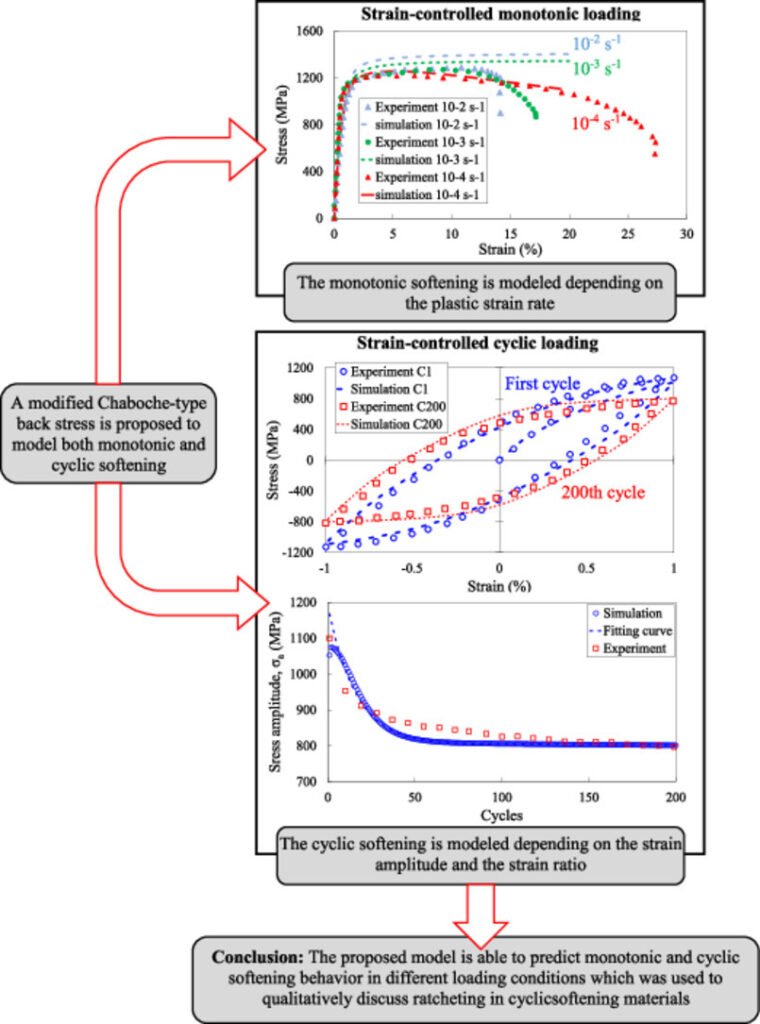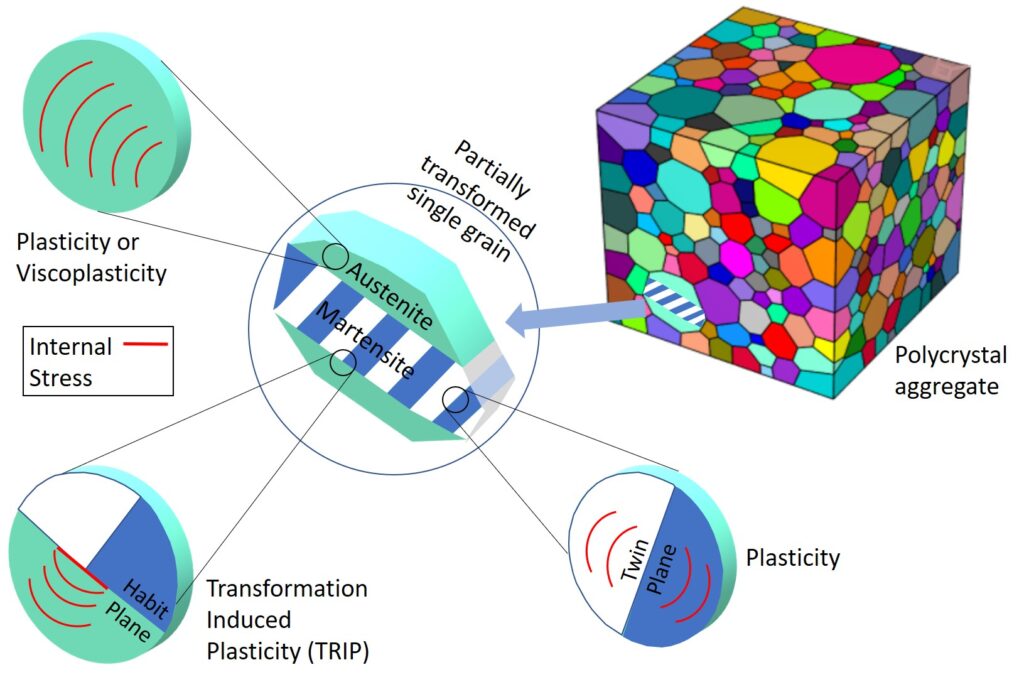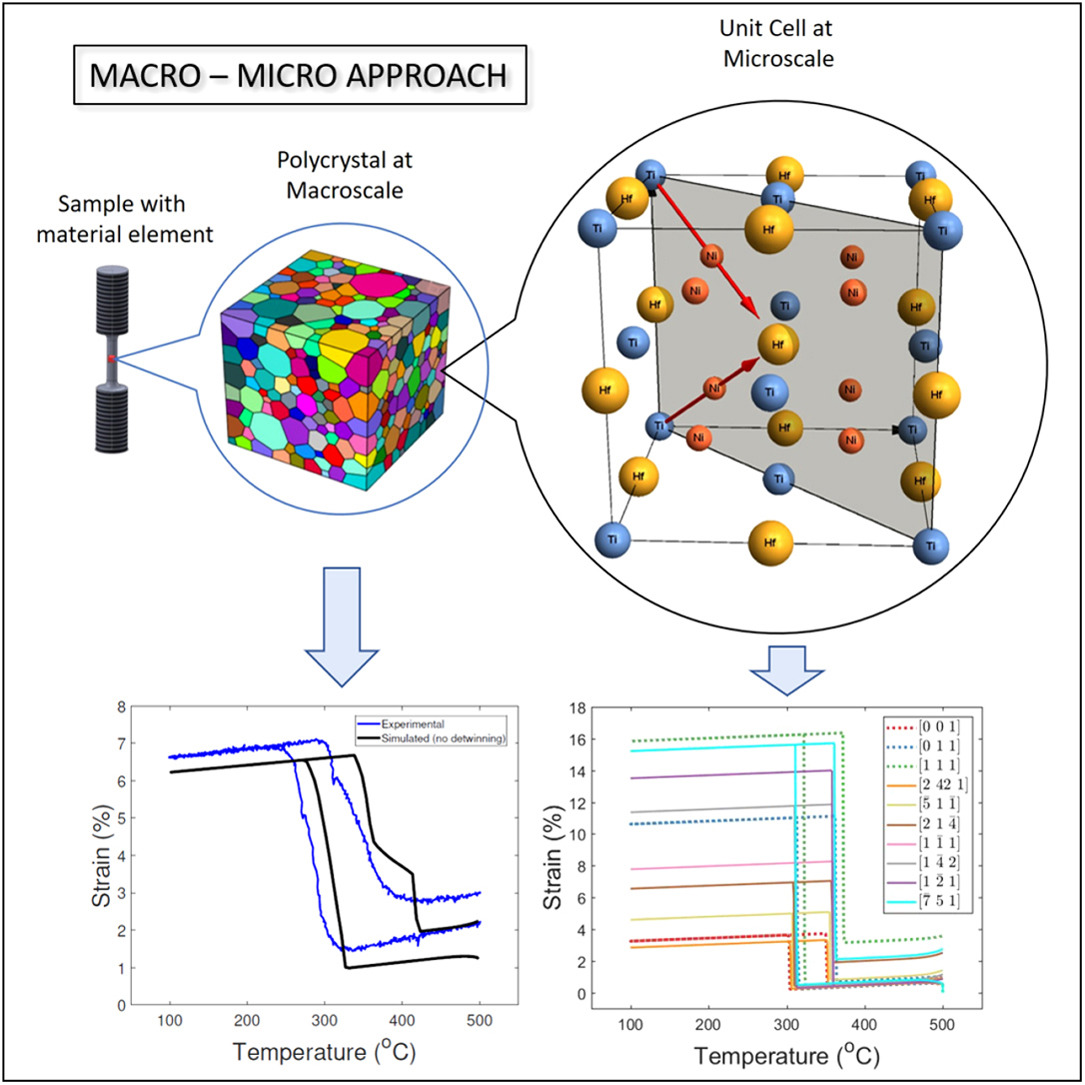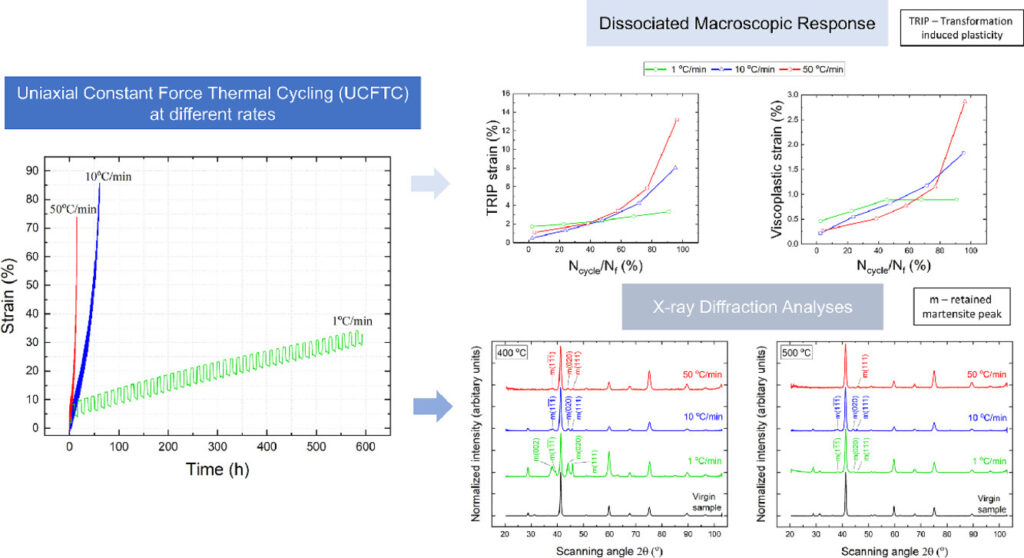* Corresponding Author – Ph.D. Student – Master Student – Undergraduate Student
Crystal-plasticity modeling of monotonic and cyclic softening in inconel 718 superalloy

J.-B. le Graverend*
International Journal of Mechanical Sciences ↗, February 2023
Abstract

A phenomenological model is proposed to predict both monotonic and cyclic softening in Inconel 718 superalloy at 650 °C. Contrary to the current cyclic softening models consisting of a modified isotropic hardening variable, an internal state variable acting on the amplitude of the back stress is proposed and implemented in a crystal-plasticity model. Crystal-plasticity finite-element simulations are performed to validate quantitatively the model on uniaxial strain-controlled monotonic and cyclic loading for several plastic strain rates and strain amplitudes as well as to gain insights on the ratcheting phenomenon depending on the mean stress and stress amplitude values when cyclic softening occurs.
Crystal-plasticity modeling of phase transformation-viscoplasticity coupling in high-temperature shape memory alloys

P. Chaugule, J.-B. le Graverend*
International Journal of Plasticity ↗, June 2022
Abstract

Phase transformation and viscoplasticity coupling in polycrystalline nickel-titanium-hafnium high-temperature shape memory alloys

P. Chaugule, O. Benafan, J.-B. le Graverend*
Acta Materialia ↗, December 2021
Abstract

A Lattice-misfit-dependent Micromechanical Approach in Ni-based Single Crystal Superalloys
J.-B. le Graverend*, R. Harikrishnan
International Journal of Mechanical Sciences ↗, April 2021
Abstract

Phenomenological modeling of the effect of oxidation on the creep response of Ni-based single-crystal superalloys
J.-B. le Graverend*, S. Lee
Extreme Mechanics Letters ↗, September 2020
Abstract
A new constitutive equation predicting the evolution of oxide thickness is proposed and implemented in a crystal plasticity framework with a hardening-based damage density function. The oxidation model depends on the initial surface roughness as well as on the amount of accumulated plastic strain and stress triaxiality. The description for the effect of oxidation on the mechanical behavior and damage is at the flow-stress level by modifying the amplitude of the kinematic hardening. The oxidation-altered kinematic hardening can predict the effect of oxidizing environments on mechanical behavior, specifically the plastic strain rate in the secondary creep stage, and lifetime. Finally, the oxidation model is verified to predict surface roughness and oxide thickness distributions by performing a finite-element simulation on a notched specimen subjected to creep and developing a complex multiaxial stress field.
A decomposition of Laplace stretch with applications in inelasticity
A. Freed*, J.-B. le Graverend & K.Rajagopal
Acta Mechanica ↗, July 2019
Abstract
The kinematics of an inelastic solid established in terms of Laplace stretch and its rate are decomposed into one stretch that describes an elastic response, another stretch that describes an inelastic response, and their rates. These kinematics are a direct consequence of Laplace stretch belonging to the group of all real, 3×3, upper-triangular matrices with positive diagonal elements. The Laplace stretch follows from a Gram–Schmidt decomposition of the deformation gradient.
Finite-Element Crystal Plasticity on Phase-Field Microstructures: Predicting Mechanical Response Variations in Ni-Based Single-Crystal Superalloys
J.-B. le Graverend*, R. Harikrishnan
Journal of Material ↗, June 2019
Abstract
The mechanical response of Ni-based single-crystal superalloys is known to be sensitive to the microstructural state, i.e., the shape and size of the γ′ precipitates when exposed to high-temperature conditions. The magnitude and sign of the natural lattice misfit between the γ and γ′ phases play the most crucial role in establishing a controlled size, shape, and distribution of γ′ precipitates during heat treatments as well as in defining the direction of rafting, viz. the directional coalescence of the γ′ precipitates. In this study, a bottom-up scale bridging strategy of using phase-field informed finite-element (FE) crystal plasticity on realistic microstructures is followed to better understand the effect of the microstructural state on the macro-scale performance of a ⟨001⟩-oriented Ni-based single-crystal superalloy. Strain-controlled tensile tests using FE crystal plasticity were performed on a set of different microstructural states: cuboidal, rafted, and topologically inverted imported from 3D phase-field simulations. The study revealed that a cuboidal microstructure with a natural lattice misfit of − 0.004 is the most ductile. As observed experimentally, the microstructure with rafts perpendicular to the loading axis (N-type) is more ductile than the cuboidal one. The P-type microstructure, i.e., with rafts parallel to the loading axis, is found to have the lowest ductility, which was attributed to lesser dislocation mobility.
A hardening-based damage model for fast evolving microstructures: Application to Ni-based single crystal superalloys

J.-B. le Graverend*
International Journal of Plasticity ↗, March 2019
Abstract
A phenomenological hardening-based damage density function built on a Rabotnov-Kachanov’s formulation and coupled to a microstructure-sensitive viscoplastic crystal plasticity model is developed for ductile materials experiencing fast-evolving microstructures. The model seats on the fact that classical continuum damage models, that only consider discontinuities of matter; viz. voids and cracks; as damage, are not able to predict the non-isothermal creep and isothermal dwell/fatigue lifetimes of materials exposed to temperature/stress conditions that trigger microstructure evolutions faster than the nucleation and growth of voids. The hereby-proposed damage model depends on microstructure-sensitive hardening variables that were previously tailored to model changes in the mechanical behavior of a Ni-based single crystal superalloy during non-isothermal loading. Furthermore, the model also proposes to predict lifetime scattering during creep by considering the initial volume fraction of pores obtained by X-ray tomography. Isothermal and non-isothermal uniaxial creep and dwell/fatigue experiments on a Ni-based single crystal superalloy are used to calibrate and validate the model. Finite element simulations are also carried out to confirm the lifetime predictive capabilities of the model on an in-plane multiaxial creep test and on multiaxial torsion and tension/torsion dwell/fatigue tests. The numerical results show that the damage model well predicts the lifetime of isothermal and non-isothermal creep as well as dwell/fatigue experiments in uniaxial and multiaxial states of stresses.
A creep-damage phase-field model: Predicting topological inversion in Ni-based single crystal superalloys
R. Harikrishnan, J.-B. le Graverend*
Materials & Design ↗, December 2018
Abstract

A Lattice-Misfit-Dependant Damage Model for Non-linear Damage Accumulations Under Monotonous Creep in Single Crystal Superalloys.
J.-B. le Graverend*
Metallurgical and Materials Transactions A ↗, May 2018
Abstract
A lattice-misfit-dependent damage density function is developed to predict the non-linear accumulation of damage when a thermal jump from 1050 °C to 1200 °C is introduced somewhere in the creep life. Furthermore, a phenomenological model aimed at describing the evolution of the constrained lattice misfit during monotonous creep load is also formulated. The response of the lattice-misfit-dependent plasticity-coupled damage model is compared with the experimental results obtained at 140 and 160 MPa on the first generation Ni-based single crystal superalloy MC2. The comparison reveals that the damage model is well suited at 160 MPa and less at 140 MPa because the transfer of stress to the γ′ phase occurs for stresses above 150 MPa which leads to larger variations and, therefore, larger effects of the constrained lattice misfit on the lifetime during thermo-mechanical loading.
Data-Driven Materials Investigations: The next Frontier in Understanding and Predicting Fatigue Behavior
A. Spear*, S. Kalidindi, B. Meredig, A. Kontsos & J.-B. le Graverend
Journal of Materials ↗, May 2018
Mechanical twinning in Ni-based single crystal superalloys during multiaxial creep at 1050°C.
J.-B. le Graverend*, F. Pettinari-Sturmel, J. Cormier*, M. Hantcherli, P. Villechaise, J. Douin
Materials Science and Engineering: A ↗, April 2018
Abstract
Multiaxial high-temperature creep tests have been performed at 1050 °C on a first-generation Ni-based single-crystal superalloy through the use of asymmetric notched specimens. Mechanical twins have been observed by EBSD and TEM analyses. A finite element simulation in a crystal plasticity framework has also been carried out to better understand the presence of mechanical twins at stress concentrators depending on stress triaxiality, plastic strain rate, and damage level.
Ex-situ X-ray tomography characterization of porosity during high-temperature creep in a Ni-based signle-crystal superalloy: Toward understanding what is damage

J.-B. le Graverend*, J. Adrien, J. Cormier
Materials Science and Engineering: A ↗, May 2017
Abstract
Creep damage by void nucleation and growth limits the lifetime of components subjected to mechanical loads at high temperatures. For the first time, the porosity of a Ni-based single crystal superalloy subjected to high temperature creep tests (T≥1000 °C) is followed by ex-situ X-ray computed tomography. A large experimental campaign consisting of nine temperature/stress conditions is carried out to determine the kinetics of the damage accumulation by voids. It is, indeed, essential to characterize their evolution to create internal variables describing properly the evolution of damage in a Continuum Damage Mechanics framework. Nonetheless, it is pointed out that the increase in the plastic strain rate during the tertiary creep stage is not necessarily related to the increase in the pore volume fraction for the alloy and temperature range explored (1000–1100 °C). Therefore, it seems that the changes in the microstructure, i.e. precipitation coarsening and γ/γ′ topological inversion, and the shearing of the γ′ particles have to be considered further to properly describe the damage evolution. Thus, the Continuum Damage Mechanics theory is undermined and should be replaced by a transformative paradigm taken into consideration microstructural evolutions in order to improve the predictability of further damage models.
Comments on ‘Selective evolution of secondary γ‘ precipitation in a Ni-based single crystal superalloy both in the γ matrix and at the dislocation nodes’
J. Cormier*, V. Caccuri, J.-B. le Graverend, P. Villechaise
Scripta Materialia ↗, March 2017
Abstract
In a recent paper, Sisi Xiang & al. [Acta Materialia 116 (2016) 343] studied microstructure evolutions of γ′ precipitates during creep of a Ni-based single crystal superalloy, with a special focus on hyperfine γ′ particles nucleating in the γ matrix channels. This paper is misleading, claiming that hyperfine γ′ particles nucleate during high temperature creep exposure at 1100 °C. The aim of the present comments is to reconsider these results based on the available literature on hyperfine γ′ particles nucleation mechanisms and subsequent morphological evolutions at high temperature.
Strengthening behavior in non-isothermal monotonic and cyclic loading in a Ni-based single crystal superalloy
J-B. le Graverend*, J. Cormier, F. Gallerneau, S. Kruch & J. Mendez
International Journal of Fatigue ↗, October 2016
Abstract
Dwell-fatigue tests and variable strain rate tensile tests followed by cycling tests were performed using 〈0 0 1〉-oriented specimens made of a first-generation Ni-based single crystal superalloy. A short thermal jump from the nominal temperature of 1050 to 1200 °C was introduced along the lifetime of dwell-fatigue experiments and at the beginning of tensile tests. A fine γ′ precipitation occurred in the γ matrix upon such event which induced a large transient strengthening effect on the mechanical properties. In fact, a transient decrease of the plastic strain rate, corresponding to a reduced magnitude in the hysteresis loops, was measured after the temperature peak during the dwell-fatigue experiments. In addition, a temperature peak produced a large hardening effect and a mechanical behavior change during the tensile tests since a hardening of 160 MPa was recorded and a perfectly plastic behavior was obtained. These transient phenomena were due to a temporary additional strengthening provided by fine γ′ precipitates lasting for the time necessary to not hinder dislocation motions anymore. Furthermore, the experimental results were also used to determine how fine γ′ precipitates modified the magnitude and the saturation speed of the isotropic and kinematic hardenings.
Issues Related to the Constitutive Modeling of Ni-based Single Crystal Superalloys under Aeroengine Certification Conditions.
J. Cormier*, F. Mauget, J-B. le Graverend, C. Moriconi & J. Mendez
AerospaceLab Journal ↗, June 2015
Broadband Electromechanical Spectroscopy: characterizing the dynamic mechanical response of viscoelastic materials under temperature and electric field control in a vacuum environment.
J.-B. le Graverend, C. Wojnar & D. Kochmann*
Journal of Materials Science ↗, March 2015
Abstract
The viscoelasticity of a variety of active materials is controllable, e.g., by the application of electric or thermal fields. However, their viscoelastic behavior cannot be fully explored by current methods due to limitations in their control of mechanical, electrical, and thermal fields simultaneously. To close this gap, we introduce Broadband Electromechanical Spectroscopy (BES). For the specific apparatus developed, specimens are subjected to bending and torsional moments with frequencies up to 4 kHz and amplitudes up to 10−4 Nm (the method is sufficiently general to allow for higher and wider frequency ranges). Deflection/twist is measured and moments are applied in a contactless fashion to minimize the influence of the apparatus compliance and of spurious damping. Electric fields are applied to specimens via surface electrodes at frequencies up to 10 Hz and amplitudes up to 5 MV/m. Experiments are performed under vacuum to remove noise from the surrounding air. Using BES, the dynamic stiffness and damping in bending and torsion of a ferroelectric ceramic, lead zirconate titanate, were measured at room temperature, while applying large, cyclic electric fields to induce domain switching. Results reveal large increases of the specimen’s damping capacity and softening of the modulus during domain switching. The effect occurs over wide ranges of mechanical frequencies and permits lowering of the resonance frequencies. This promises potential for using ferroelectrics for active vibration control beyond linear piezoelectricity. More generally, BES helps improve current understanding of microstructure kinetics (such as during domain switching) and how it relates to the macroscopic viscoelastic response of materials.
Creep of a nickel-based single-crystal superalloy during very high temperature jumps followed by synchroton X-ray diffraction.
J.-B. le Graverend*, A. Jacques, J. Cormier, O. Ferry, T. Schenk, J. Mendez
Acta Materialia ↗, February 2015
Abstract
Complex thermomechanical loadings at high temperature (T ⩾ 950 °C) on the AM1 single-crystal superalloy were studied by X-ray diffraction under synchrotron radiation. This technique enables in situ access to the evolutions of the lattice mismatch as well as the volume fraction and the dislocation density of the γ and γ′ phases during high-temperature non-isothermal creep loadings. It is shown that the large microstructure evolutions through the growth/shrinkage of γ/γ′ interfaces due to the γ′ volume fraction changes and the associated variations in the density of dislocations at these interfaces during temperature jumps are key parameters controlling the whole behavior (distribution of internal stresses and constitutive laws) of both phases. We propose an empirical constitutive law linking the strain rate of the γ′ phase to its stress state as well as a way to determine it. During our experiments, the plastic behavior of the γ′-rafts is related to the entry of dislocations with Burgers vectors perpendicular to the tensile axis and controlled by the overcoming of a threshold stress corresponding to the internal stress components perpendicular to the tensile axis.
Broadband control of the viscoelasticity of ferroelectrics via domain switching.
C.S. Wojnar, J.-B. le Graverend, D.M. Kochmann*
Applied Physics Letters ↗, October 2014
Abstract
We show that the viscoelastic properties of polycrystalline ferroelectric ceramics can be significantly altered over a wide range of mechanical frequencies when domain switching is controlled by cyclic electric fields. The dynamic stiffness of lead zirconate titanate is shown to vary by more than 30%, while damping increases by an order of magnitude. Experimental results are interpreted by the aid of a continuum-mechanics model that captures the nonlinear electro-mechanically coupled material response for the full electric hysteresis.
A microstructure-sensitive constitutive modeling of the inelastic behavior of single crystal nickel-based superalloys at very high temperature.
J.-B. le Graverend*, J. Cormier, F. Gallerneau, P. Villechaise, S. Kruch, J.Mendez
International Journal of Plasticity ↗, August 2014
Abstract
The prediction of the viscoplastic behavior of nickel-based single crystal superalloys remains a challenging issue due to the complex loadings encountered in aeronautical engine components such as high pressure turbine blades. Under particular in-service conditions, these materials may experience temperature cycles which promote the dissolution of the strengthening γ′ phase of the material on (over)heating, and subsequent precipitation on cooling, leading to a transient viscoplastic behavior.
Within this context, a model was recently developed by Cormier and Cailletaud (2010) to fulfill the effects of fast microstructure evolutions occurring upon high temperature non-isothermal loadings. New internal variables were introduced in the crystal plasticity framework to take into account microstructure evolutions such as γ′ dissolution/precipitation and dislocation recovery processes which are known to control the creep behavior and life. Nevertheless, this model did not consider the γ′ directional coarsening, one of the main microstructural evolutions occurring specifically at high temperature. In addition, no kinematic hardening was considered to describe the mechanical behavior, leading to a poor description of cyclic loadings.
This paper details the development of a new model by introducing new internal variables for both modeling the γ′ directional coarsening and the evolutions of isotropic and kinematic hardening under complex loading paths.
This model was calibrated using monotonous and cyclic experiments performed on [0 0 1] oriented single-crystal samples and both under isothermal and non-isothermal conditions. Thereby, it is able to predict microstructural evolutions for complex thermal and mechanical loadings as well as internal stress evolutions whatever the thermomechanical history. The model efficiency was highlighted by comparing FEM simulation and experimental results of a non-isothermal creep test on a notched sample (i.e. under complex mechanical stress state).
Highly non-linear creep induced by a short close -solvus overheating and a prior microstructure degradation on a nickel-based single crystal superalloy.
J.-B. le Graverend*, J. Cormier, F. Gallerneau, S. Kruch & J. Mendez
Material & Design ↗, April 2014
Abstract
Specific non-isothermal creep conditions were applied to a 1st generation single crystal nickel based superalloy at very high temperature. Creep tests were conducted under 120 and 160 MPa at 1050 °C with one overheating under stress at 1200 °C for 30 s. Results were compared to the ones already obtained under 140 MPa on the same alloy as well as on a fourth generation of alloy.
It is shown that the residual creep life after a single overheating is optimal after a specific prior-creep time. The impact of the creep degradation prior to an overheating on the creep life is dependent on the magnitude of the effective γ/γ′ lattice mismatch. Indeed, an overheating performed when the effective γ/γ′ mismatch magnitude is maximum leads to longer creep lives, even better than without overheating.
Microstructural Parameters Controlling High-Temperature Creep Life of the Nickel-Base Single-Crystal Superalloy MC2
J.-B. le Graverend*, J. Cormier, S. Kruch, F. Gallerneau & J. Mendez
Metallurgical and Materials Transactions A ↗, May 2012
Abstract
The influence of both topologically close-packed (TCP) phase precipitation and pores on the creep life of a single-crystal superalloy has been studied at 1323 K (1050 °C)/160 MPa. Despite very reproducible primary and secondary creep stages, the creep life is scattered for this specific condition where a very steep tertiary creep stage is observed, corresponding to a highly localized failure process. Image processing was performed after failure to determine the stereological parameters characterizing pores and TCP-phase particles. It was determined that pores are major determinants of creep life under these temperature and stress conditions. It was also observed that the average surface area or the density of pores is not sufficient to explain creep life variability. A homogenization method including modified γ/γ′ microstructure area surrounding pores and TCP-phase particles was developed and correlated to creep life. It is shown that the greater the extent of the modified microstructure, the lower the creep life. Moreover, a better understanding of the TCP-phase role in controlling the creep life was obtained: TCP-phase particles modified the local stress field and disturbed the local γ/γ′ microstructure. They enhance the generation of vacancies and subsequent nucleation and growth of pores.
In Situ Measurement of γ/γ’ the Lattice Mismatch Evolution of a Nickel-Based Superalloy During Non-isothermal Very High-Temperature Creep Experiments.
J.B. le Graverend, L. Dirand, A. Jacques, J. Cormier*, O. Ferry, T. Schenk, F. Gallerneau, S. Kruch & J. Mendez
Metallurgical and Materials Transactions A ↗, September 2012
Abstract
The evolution of the γ/γ′ lattice mismatch of the AM1 single-crystal superalloy was measured during in situ non-isothermal very high-temperature creep tests under X-ray synchrotron radiation. The magnitude of the effective lattice mismatch in the 1273 K to 1323 K (1000 °C to 1050 °C) temperature range always increased after overheatings performed at temperatures lower than 1403 K (1130 °C). In contrast, a decrease of its magnitude was observed after overheatings at temperatures greater than 1453 K (1180 °C) due to massive dislocation recovery processes occurring at very high temperature.
Dissolution of Fine γ’ Precipitates of MC2 Ni-Based Single-Crystal Superalloy in Creep-Fatigue Regime.
J.B. le Graverend, J. Cormier, F. Gallerneau, P. Paulmier
Advanced Materials Research ↗, July 2011
Abstract
The dissolution kinetics of an ultra-fine γ’ precipitation occurring in the γ matrix between the standard secondary precipitates of MC2 Ni-based single crystal superalloy was investigated. Creep-fatigue experiments at 1050°C including an overheating at 1200°C were performed on <111> oriented specimens to study the effects of fine γ’ particles on the plastic deformation. During these experiments, a decrease of the plastic deformation rate was observed just after the temperature peak. This hardening effect disappears once the fine γ’ precipitates had been dissolved. A mean time for this hyperfine precipitation dissolution could then be highlighted. Based on both simple binary diffusion and complex diffusion analysis, the mean time for the dissolution of the fine γ’ precipitates is analyzed and compared to the experimental ones. It is shown that considering only a simple binary diffusion is not sufficient and it should be considered a more complex diffusive analysis involving additional interplays.
Numerical simulation of γ/γ’ microstructural evolutions induced by TCP-phase in the MC2 nickel base single crystal superalloy.
J.B. le Graverend, J. Cormier, P. Caron, S. Kruch, F. Gallerneau, J. Mendez
Materials Science and Engineering: A ↗, December 2010
Abstract
The influence of topologically close packed-phase (TCP-phase) precipitation on the γ/γ′ microstructure evolution of a single crystal superalloy has been studied. Four representative configurations of needle-shaped μ-phase particles observed in the MC2 alloy after creep deformation at 1050 °C/160 MPa have been selected.
Finite element modeling was performed on the selected configurations using a crystal plasticity framework and a viscoplastic approach.
The local calculated stress/strain fields in the vicinity of TCP-phase precipitates, especially stress concentration, allow an interpretation of the observed microstructural evolutions (γ′-precipitate orientation and thickness).
Moreover, our numerical simulation brings a fruitful contribution to the understanding of the phenomenon often observed beyond needle-like μ-phase: the formation of a distorted γ/γ′ microstructure in lieu of the expected γ/γ′-rafted structure.
Effect of fine γ′ precipitation on non-isothermal creep and creep-fatigue behavior of nickel base superalloy MC2.
J.-B. le Graverend*, J. Cormier, M. Jouiad, F. Gallerneau, P. Paulmier, F. Hamon.
Materials Science and Engineering: A ↗, May 2010.
Abstract
A novel technique, combining on the one hand creep-fatigue tests with an overheating and creep tests with thermal cycling in the other hand, performed on γ/γ′ nickel base single crystal superalloy MC2 have led to an increased understanding of fine γ′ precipitation and its strengthening effect.
Both creep and creep-fatigue tests were conducted at 1050 °C with 1200 °C overheating for creep-fatigue experiments and with repeated overheatings at 1100 °C and 1150 °C for creep.
The resulting microstructures of these experiments were examined using both scanning electron microscopy (SEM) and transmission electron microscopy (TEM). It appears, both on creep or creep-fatigue, once an overheating is experienced a fine γ′ precipitation occurs in γ matrix. These precipitates seem to have a transient strengthening effect on the mechanical properties. For the creep-fatigue experiments a decrease of the plastic strain rate was measured at once after the temperature peak. In the case of the creep tests under thermal cycling, no extra deformation induced by the overheating at 1100 °C was recorded. However, overheatings at 1150 °C lead to a plastic strain jump which progressively decreases upon thermal cycling, due to the formation of fine γ′ precipitates. Furthermore, the γ′ fine particles seem to have a hardening effect that vanishes once they dissolve.
Alkaline Water Electrolysis Resistance Evolution at Normal Earth Gravity and Under Zero Gravity Conditions
P. Mandin*, J.-B. le Graverend, R. Wüthrich, Y. Fukunaka.
Electrochemical SocietyTransactions ↗, August 2009.
Electrical Resistance Evolution During a Small Scale Two-phase Electrolysis.
P. Mandin*, J.-B. le Graverend, R. Wüthrich, H. Roustan.
Electrochemical Society Transactions ↗, August 2009.

